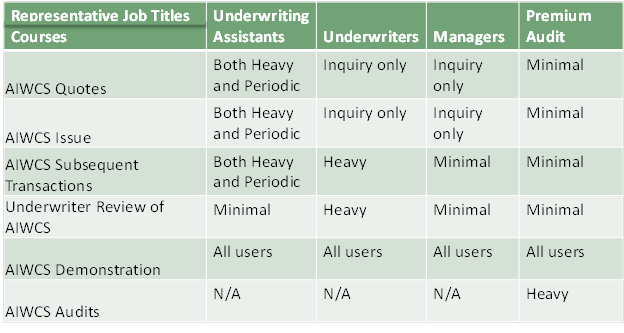Key Results Summary
Training Needs Analysis for New Workers Compensation Underwriting System
Situation:

The business units underwriting workers compensation insurance policies for a major international insurance firm joined together to develop a new business processing system. This impacted several business units and was a major source of division revenue and profit. Senior management requested training with the following requisites:
- All users to be trained and converted to the new system within three months with the least impact on their work time as possible.
- Training to be classroom-based with a business expert participating in each session to answer technical business questions.
- Focus training to each business unit and to the unique usage within those units.
Training requirements had to be determined for purposes of developing curriculum but also to estimate the total training time for each location, business unit, and in aggregate. This was necessary to set the pace for office conversions and ascertain if a three month conversion window was feasible.
Action Plan:
The following data gathering efforts were initiated:
- All users were identified through human resources by name, division and job title with their manager’s name.
- A survey was sent to each manager requesting they identify the way that their users use the existing system by each job title reporting into them.
- Functionality between to old and news systems was mapped.
- Using the survey results, existing functional usage was mapped to new system usage for each job title. These results were reviewed and approved by business management.
- The system usage volume was also tabulated by job titles and business units.
- A matrix of functionality and job title usage identified common training needs for specific groups of job titles and business units. It also showed there were distinct differences in the volume of system use within job titles. The variance was partially related to job title but also varied by the volume of business being processed and within different business units.
- The system’s functionality was easily packaged into training modules. However, mapping those modules to job titles and business units created too many sub-groups to efficiently train the total audience. Analysis of the usage data easily grouped users into four categories that reflected their usage type and/or volume.
Results:
The proposed training modules were mapped to the four usage groups. Total training time for the individual users within each group could then be estimated. This provided the data to model total training time by location to evaluate deployment calendars and determine the feasibility of the three month deployment window.
The four groups and their training time requirements were identified as:
- Inquiry users 0.5 day
- Minimal users 1 day
- Heavy users 2 days
- Periodic users get 3 days (less familiar with the business rules hence longer training)
Training was developed in six components modules that could be mixed and matched to meet the needs of each of the four usage groups.

This process and analysis created much better aggregate groups within each training location from which to estimate training time and schedule classes.
